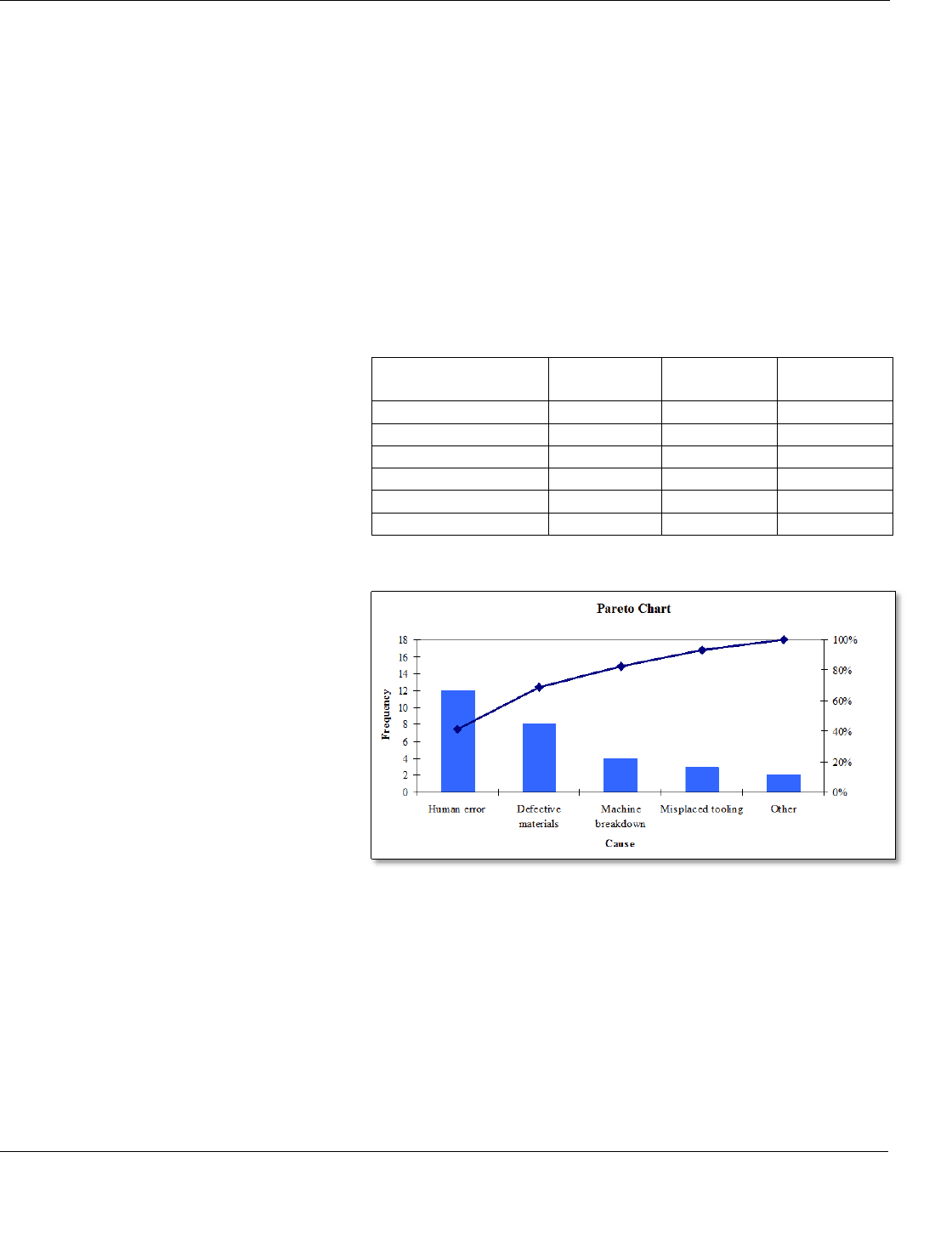Hill A.V. The Encyclopedia of Operations Management: A Field Manual and Glossary of Operations Management Terms and Concepts
Подождите немного. Документ загружается.


ptg6843605
opportunity cost – optimization
The Encyclopedia of Operations Management Page 246
strategic requirements of the business. In other words, the operations organization should always strive to make
decisions that are consistent with the competitive strategy being pursued by the strategic business unit. Hayes
and Wheelwright (1984, p. 31) developed the following list of “manufacturing strategy decision categories” and
divided the list into two sets – structure and infrastructure:
Structure
Capacity – Amount, timing, type
Facilities – Size, location, specialization
Technology – Equipment, automation, linkages
Vertical integration – Direction, extent, balance
Infrastructure
Workforce – Skill level, wage policies, employment security
Quality – Defect prevention, monitoring, intervention
Production planning/materials control – Sourcing policies, centralization, decision rules
Organization – Structure, control/reward systems, role of staff groups
Whereas structural decisions are physical, longer term, and more difficult to change, infrastructural decisions
are more tactical and require less visible capital investments (but can still be difficult to change). Hayes and
Wheelwright argue that these eight decision areas are closely interrelated and that “it is this pattern of structural
and infrastructural decisions that constitutes the manufacturing strategy of a business unit” (Hayes &
Wheelwright 1984, p. 32). This framework is closely related to the McKinsey 7S Model.
Other entries in the EOM – The balanced scorecard, strategy map, and causal map entries discuss strategy
process issues in more detail. The strategy map entry presents the time-based competition strategy. The mass
customization entry presents customization as a potential component of an operations strategy. Outsourcing to
achieve lower cost is also a component of an operations strategy. A focused factory is an important
manufacturing strategy, and the Service Profit Chain is an important service operations strategy. The push-pull
boundary and postponement entries deal with the customer interface, leadtime, and customization issues.
See 7S Model, agile manufacturing, balanced scorecard, blue ocean strategy, cash cow, catchball,
competitive analysis, core competence, first mover advantage, five forces analysis, focused factory, industry
analysis, mass customization, offshoring, operations management (OM), order qualifier, outsourcing, plant-
within-a-plant, postponement, push-pull boundary, resource based view, respond to order (RTO), robust, sand
cone model, Service Profit Chain, strategy map, supply chain management, sustainability, SWOT analysis,
technology push, time-based competition, vertical integration, virtual organization.
opportunity cost – The value of an alternative (opportunity) that was not taken.
When people have a choice between two or more alternatives, they will generally choose the best one.
However, choosing the best alternative means that they cannot choose the next best alternative. The opportunity
cost is the value of the next best alternative that must be sacrificed, i.e., “the value of the road not taken.”
For example, a firm can only make one product in a factory and decides to build product A instead of B.
Although it makes a profit on product A, it gave up the profit on product B. The forgone profit on product B is
called the opportunity cost.
For a more specific example, consider a factory that has one large machine (the bottleneck) that constrains
the plant’s production rate. The firm makes $1,000 per hour in gross revenue every hour the machine is running.
The firm currently has a setup time on this machine of one hour per day, which means that the firm could make
$1,000 more per day if the setup could be eliminated. The standard costing system assigns direct labor and
overhead to this machine at a rate of $200 per machine hour. However, the true cost of the setup is much more
than $200 per hour because of the opportunity cost (i.e., the lost gross margin).
See carrying cost, economics, overhead, setup cost, stockout, Theory of Constraints (TOC).
Optical Character Recognition (OCR) – A technology that enables a machine to translate images into text.
See Automated Data Collection (ADC), Electronic Product Code (EPC), lockbox.
optimization – An operations research term for mathematical techniques that find the best solution to a problem.
Optimization techniques can be classified as either unconstrained or constrained optimization.
Unconstrained optimization methods include calculus and numerical methods (search methods). Constrained
optimization methods include linear programming, integer programming, and many other mathematical
programming methods. Optimization techniques can also be classified as deterministic (has no uncertainty) or
stochastic (allows for uncertainty). For example, finding the optimal safety stock is usually modeled as an

ptg6843605
order backlog − order-up-to level
Page 247 The Encyclopedia of Operations Management
unconstrained stochastic optimization problem, and finding the minimum cost allocation of products to
warehouses in a distribution network is usually modeled as a constrained deterministic optimization problem.
Although many students use the term “optimize” to describe any situation where they are attempting to find
the best solution, most professors prefer to reserve the word to only describe situations where the mathematically
best solution is guaranteed to be found by a mathematical optimization procedure.
Excel provides useful optimization tools with (1) Goal Seek (for unconstrained optimization) and (2) the
Solver (for both unconstrained and constrained optimization). Excel can be used with the Solver (and VBA as
needed) to develop practical decision support systems for many important supply chain and operations
management optimization problems (Winston & Albright 2011).
See Advanced Planning and Scheduling (APS), algorithm, Decision Support System (DSS), genetic
algorithm, heuristic, linear programming (LP), network optimization, operations research (OR), simulated
annealing.
order backlog – See backlog.
order cost – The marginal cost of placing one more purchase or manufacturing order; synonymous with setup cost.
Order cost increases with the number of orders. It includes costs related to the work of preparing, shipping,
releasing, monitoring, receiving inspection, and put away. The setup cost entry provides more details.
See inventory management, marginal cost, setup cost.
order cycle – The time between receipts for the orders of an item; also called the replenishment cycle.
The number of order cycles per year can be estimated as D/Q, where D is the forecasted annual demand and
Q is the average order quantity. The reorder point entry presents a graph that shows several order cycles.
See reorder point, safety stock, service level, stockout.
order cycle service level – See safety stock.
order entry – The process (and the related organizational unit) of receiving customer sales order information and
entering it into a fulfillment system.
Order entry systems communicate important information to customers, such as prices, terms, availability,
promise dates, technical product information, and payment options (cash, credit, credit card, etc.). People taking
orders (customer service representatives) may act as salespersons and pursue opportunities to cross-sell
complimentary products and up-sell more expensive products. After the order has been entered into the system,
the system will create information for picking, shipping, and invoicing.
See call center, configurator, cross-selling, customer service, fulfillment, functional silo.
order fill rate – See fill rate.
order fulfillment – See fulfillment.
order penetration point – See push-pull boundary.
order picking – See picking.
order point system – See reorder point.
order qualifier – An attribute of a product or service that is necessary for customers to consider buying; also called
an order loser.
An order qualifier is a characteristic that customers use to screen products for further evaluation. In
contrast, an order winner makes a critical difference in the buyer’s decision process. In other words, the order
qualifier “gets the salesperson in the door” to be considered by the potential buyer and the order winner “gets the
salesperson out the door with the order in hand” (i.e., seals the deal and beats out the competition).
For example, the order qualifier for some buyers looking for a watch might be a price under $100. However,
the order winner might be other product characteristics, such as the warranty or the wristband.
See operations strategy.
order quantity modifier – See lotsizing methods.
order size – See lotsize.
order winner – See order qualifier.
order-to-cash – The time between the receipt of the order from the customer and the receipt of the payment from
the customer.
See cycle time, respond to order (RTO).

ptg6843605
order-up-to level – outbound logistics
The Encyclopedia of Operations Management Page 248
order-up-to level – An inventory control term for a maximum inventory level; also called base stock, target
inventory, max, maximum, model stock, and par level; in academic literature, often called an S system.
An inventory system using an order-up-to level policy calculates the order quantity as the order-up-to level
minus the current inventory position. The optimal order-up-to level is the optimal safety stock plus the average
demand per period times leadtime plus review period (i.e.,
( )
d
T SS L P
). With a continuous review
system, the review period is zero.
See inventory management, inventory position, joint replenishment, min-max inventory system, periodic
review system, reorder point.
ordinal scale – See scales of measurement.
organizational design – (1) The structure that defines the duties, goals, decision rights, policies, and reporting
relationships for individuals or groups of people in an organization. (2) The process of creating such a structure.
Organizational design structure – Although an organizational design is reflected in an organizational chart,
it is much more than a chart. Some examples of organizational design structures include:
• Centralized structure – Decision rights are concentrated in the top management, and tight control is exercised
over departments and divisions.
• Decentralized structure – Decision rights are distributed, and the departments and divisions have more
autonomy.
• Hierarchical structure – A common centralized structure where clear reporting lines are drawn, with each
manager typically having several direct reports.
• Functional structure – Organizations are divided along areas of expertise, such as engineering and marketing.
This structure is usually efficient within functional areas.
• Divisional (product) structure – An example of a decentralized structure, where the organization is divided
into geographical or product-based divisions.
• Matrix structure – A structure that uses cross-functional and cross-divisional teams to deliver products,
where team members often report to both a functional boss and a project leader outside their function.
Organizational design process – Organizational design is the process of aligning the people in an
organization to meet its strategic objectives. Organizational design activities start with the organization’s goals
and take into account the current organizational structure, skills and abilities of its people, job functions, and
uncertainty in the external environment. The process seeks to form the organization into a structure that best
suits its value proposition.
See absorptive capacity, cross-functional team, High Performance Work Systems (HPWS), human resources,
job design, job enlargement, RACI Matrix, self-directed work team, virtual organization, workforce agility.
organizational structure – See organizational design.
Original Design Manufacturer (ODM) – See contract manufacturer.
Original Equipment Manufacturer (OEM) – An organization that sells products made by other organizations
under its own name and brand.
Contrary to what the name “original equipment manufacturer” suggests, the OEM is not the manufacturer,
but rather the re-seller of the equipment to the end user. More fitting terms include “original equipment
customizer,” “original equipment designer,” or “original equipment concept designer.” The OEM is usually the
customizer or designer of the product and usually handles marketing, sales, and distribution. The OEM usually
offers its own warranty, support, and licensing of the product.
In many cases, the OEM merely brands the equipment with its own logo. The OEM’s name is either placed
on the devices by the manufacturer that makes the equipment or by the OEM itself. In some cases, the OEM
does add value. For example, an OEM might purchase a computer from a company, combine it with its own
hardware or software, and then sell it as a turnkey system (see Value Added Reseller).
Some firms specialize in OEM manufacturing but never sell anything under their own brands (see contract
manufacturer). Many manufacturing companies have separate OEM divisions for goods that are private labeled.
The entry contract manufacturer discusses Electronics Manufacturing Services (EMS) and Contract
Electronics Manufacturing Services (CEMS), which are special types of OEMs.
See contract manufacturer, private label, turnkey, Value Added Reseller (VAR).

ptg6843605
OSHA − outsourcing
Page 249 The Encyclopedia of Operations Management
OSHA – See Occupational Safety and Health Administration (OSHA).
outbound logistics – See logistics.
outlier – A statistical term used to describe an observed value that is out of the ordinary and therefore should not be
included in the sample statistics.
Outliers can have a significant impact on the sample mean and variance. They can be attributed to either
special causes (such as measurement error) or a heavy-tailed distribution. When outliers can be attributed to
special causes, they should be removed from the sample. For example, this author set up a forecasting system for
a firm that had a once-per-year shipment to Belgium. Removing this large planned shipment from the data made
it easier to forecast the demand. A reasonable rule of thumb is to exclude observations that are above (below) the
mean plus (minus) three standard deviations. However, it is foolish to exclude outliers from a sample unless the
analyst has good theory behind doing so. In many cases, outliers provide important information about the
distribution and the variable in question.
One approach for dealing with outliers is to use robust (error-resistant) statistics, such as the median. Unlike
the mean, the median is not affected by a few outliers in the data. Other robust statistics include trimmed and
Winsorized estimators and the interquartile range.
See control chart, interquartile range, linear regression, Mean Absolute Deviation (MAD), run chart, special
cause variation, trim, trimmed mean, Winsorizing.
outsourcing – Buying products and services from an independent supplier.
Many popular articles imply that “outsourcing” is buying products or services from Asia or from some other
part of the world. However, the correct definition of outsourcing is buying product or services from any outside
firm. Sourcing products and services from a wholly owned subsidiary on another continent should be called
“offshoring” rather than outsourcing; buying products or services from another firm on another continent should
be called “offshore outsourcing.”
A good example of outsourcing is Boston Scientific’s clean room gowns. Boston Scientific’s core
competence is designing, manufacturing, marketing, and selling implantable medical devices – not managing
gowns. However, its gown supplier has a clear focus on clean room gowns and is “world class” at that business.
Therefore, Boston Scientific outsources its gown management. An example of outsourcing services is Best Buy,
which outsourced many of its IT and human resources functions to other firms.
Nearly all consultants and management professors argue that firms should not outsource their core
competence. However, this statement is not always helpful, because many managers have trouble identifying
their organization’s core competence and find that their core competence changes over time.
Some penetrating questions that managers should ask with respect to outsourcing include:
If this process is a core competency, why are we making it only for ourselves? If a firm has a truly
world-class process, then why not leverage that expertise (and overhead)? The answer to this question is
often, “Well, the process is really not that good,” which suggests that the process is not a true core
competence after all.
If the process is not a core competency, why not buy it from someone who has this core competency?
If a process is clearly not a core competence and never will be, then management should ask why not
outsource it from another organization that has a core competency in this area?
Are we ready to become dependent on others for this process? When outsourcing manufacturing,
management is, in effect, deciding that the process is not a core competency and is creating dependency on
other firms. When a firm outsources, it will no longer have those 20-year veterans who know everything
there is to know about esoteric materials, equipment, and testing. The firm gives up the equipment, tools,
and expertise. Over time, the firm may even erode its ability to talk intelligently to its suppliers and
customers. This is not a significant problem as long as the process is clearly not a core competency and the
firm has good suppliers who have this core competency.
Do we understand the switching costs? Switching is often difficult and costly and involves many systems,
such as machines, tooling, people, expertise, information systems, coordination, transportation, production
planning, and costing. Moreover, switching back may be just as costly if management changes its mind.
Many firms find that they can improve both cost and quality if they can find an outside supplier that has a
core competence in a particular area. For example, historically many firms have outsourced the manufacturing of

ptg6843605
Over/Short/Damaged Report – Over/Short/Damaged Report
The Encyclopedia of Operations Management Page 250
components. More recently, we have seen firms outsourcing final assembly, new product development, and
many services, such as IT and human resources.
Given that outsourcing often increases inventories, outsourcing can go against lean principles. For example,
if a firm outsources a component to China and dramatically increases leadtimes, inventory and the associated
carrying cost will also increase dramatically. Some experts consider Dell to be an example of successful lean
outsourcing, because it outsources nearly all its component manufacturing and yet carries nearly zero component
inventory
39
. If managed properly, outsourcing, in combination with smart supplier agreements and Vendor
Managed Inventories, can sometimes result in a significant decrease in inventories and provide excellent
synergies with lean manufacturing.
Many firms fail to understand that many overhead costs do not go away (at least, not in the short term) with
an outsourcing decision. Some of the “surprise” overhead costs that come with an outsourcing decision include:
Overhead costs allocated to production in the high-wage location, which must be re-allocated to remaining
products. In other words, some of the fixed costs do not go away in outsourcing, and the internal burden
rates go up and the volume goes down. (See the make versus buy decision entry.)
Carrying cost of the additional inventory of goods in transit (the square root law).
Cost of additional safety stocks to ensure uninterrupted supply.
Cost of expedited shipments.
Cost of scrap-related quality issues.
Cost of warranty claims if the new facility or supplier has a long learning curve.
Cost of engineer visits to set up the operation or straighten out problems.
Cost of stockouts and lost sales caused by long leadtimes.
Cost of obsolete parts.
Outsourcing decisions sometimes also fail to properly account for currency risks, country risks, connectivity
risks, and competitive risks when a supplier becomes a competitor.
Contracts are not always enforceable across international borders, particularly in countries that do not have
well-developed legal systems. Therefore, the manufacturer will assume some risk with both the intellectual
property (product designs and process designs) and during the order-to-cash cycle for any order. However, all
business relationships involve risk, so it comes down to developing trust between the business partners. If the
supplier wants to keep the manufacturer as a customer, it needs to prove itself trustworthy. Firms, on the other
hand, need to weigh this risk against the risk of global competitors coming to the market with a significantly
cheaper and better product.
The World Is Flat (Friedman 2005) identified ten forces that flattened the world and made offshore
outsourcing much easier: (1) the fall of the Berlin Wall (11/9/89), (2) Netscape (8/9/95), (3) workflow software,
(4) open-sourcing (blogs, wikis) allowing people to upload and collaborate, (5) outsourcing, (6) offshoring, (7)
supply-chaining, (8) insourcing (B2B services)
40
, (9) in-forming, and (10) wirelessness.
See absorptive capacity, Activity Based Costing (ABC), burden rate, business process outsourcing, carrying
cost, contract manufacturer, co-packer, core competence, delegation, groupware, human resources, intellectual
property (IP), labor intensive, landed cost, make versus buy decision, maquiladora, nearshoring, offshoring,
operations strategy, overhead, purchasing, Service Level Agreement (SLA), sourcing, subcontracting, supply
chain management, switching cost, vendor managed inventory (VMI), vertical integration.
Over/Short/Damaged Report – A transportation management report that highlights any items that were received
but unexpected (i.e., more than what was ordered), expected but not received (i.e., short of what was ordered), or
received in damaged condition; also called the OS&D report.
An Over/Short/Damaged report is commonly run for a single inbound trailer or for a day’s worth of inbound
trailers to gauge the quality of the shipments. Ideally, an OS&D report should be completely empty with no
unexpected, missing, or damaged items.
The OS&D report is typically created by the Transportation Management System or Warehouse Management
System. The OS&D report is created by comparing the list of items the firm expected to receive (typically from
39
Some experts argue that Dell is not lean because their suppliers carry much of their inventory.
40
Friedman uses the term “insourcing” here very differently than the way most supply chain managers use the term.

ptg6843605
Overall Equipment Effectiveness (OEE) − overhead
Page 251 The Encyclopedia of Operations Management
the Advanced Shipping Notification) with the actual receipts as recorded by the warehouse personnel who
handled the receiving. Often this OS&D report is created by comparing the barcode scans of the wireless devices
used during receiving with the ASN file that defines what should have been in the trailer.
The OS&D report is important to managers for several reasons:
Overage items will probably need manual intervention – Normally, in a cross-dock or warehousing
scenario, each incoming item has an ultimate destination (typically another warehouse or some end shipping
point). This destination is indicated in the ASN file. If an unexpected item is received in a high-volume
cross-dock or warehousing environment, manual intervention will be required to determine the appropriate
ultimate destination of the item.
Missing items will need manual intervention – In normal circumstances, each item has an ultimate
destination. If items are missing, warehouse managers may need to alert downstream warehouses or
customers of missing goods.
Proper recording of damages limits liability – In many logistics scenarios, the company takes ownership
of the items only after they have been received in good condition. Any damage to items after receipt will be
the responsibility of the recipient. Therefore, if damaged items are received, it is important that the damage
be noted immediately. Good wireless Transportation Management Systems (TMS) and Warehouse
Management Systems (WMS) make it easy for warehouse personnel to record damaged goods upon receipt.
From a high-level management perspective, the OS&D report can be used to evaluate the overall
effectiveness of the relationship between the originator of the shipment and the recipient of the shipment.
See Advanced Shipping Notification (ASN), cross-docking, Electronic Data Interchange (EDI), logistics,
receiving, shortage report, Transportation Management System (TMS), Warehouse Management System (WMS).
Overall Equipment Effectiveness (OEE) – A lean operations/TPM metric defined as the product of three
variables – the availability rate, performance rate, and yield (or quality) rate.
Overall Equipment Effectiveness (OEE) is considered by many to be a key metric for lean operations
management. OEE is used extensively in Total Productivity Management (TPM) applications, particularly in
large firms, such as 3M, that have large capital intensive operations. OEE is the product of three variables:
(Availability Rate) x (Performance Rate) x (Yield Rate). Each of these three variables is defined as follows:
• Availability rate = (Operating time less downtime)/(Total operating time). This measures downtime losses
due to changeovers, equipment failures, and startup losses. Availability is not the same as utilization.
Availability captures downtime losses from emergency maintenance, setups, and adjustments.
• Performance rate = (Total output)/(Potential output at rated speed). This measures speed losses due to
idling and minor stoppages or reduced speed operation.
• Yield (or quality) rate = (Good output)/(Total output). This measures defects and rework. The yield rate
for OEE is sometimes called the quality rate or first-pass yield rate.
If OEE is applied to a non-bottleneck machine, care must be taken to avoid maximizing utilization and
building inventory long before it is needed. It does not make sense to maximize one asset (a machine) to create
another asset (inventory) that sits idle for a long time. When properly implemented, OEE will maximize
availability (which is not the same as utilization).
See capacity, downtime, effectiveness, efficiency, lean thinking, operations performance metrics, process
capability and performance, productivity, rework, Total Productive Maintenance (TPM), utilization, value added
ratio, yield.
overhead – Business costs that cannot be meaningfully and easily assigned to individual products or services;
sometimes called indirect cost or burden.
Overhead costs include all costs to conduct business except for direct labor and direct materials. These costs
include indirect labor, indirect materials, selling expenses, general and administrative expenses, depreciation,
setup costs, quality costs, cleanup costs, fringe benefits, payrolls taxes, and insurance. Examples of overhead
costs include the building and machine depreciation, building utilities (power, water, sewer), MRO supplies (e.g.,
sandpaper), office supplies (pens and paper), and supervisory labor. Manufacturing overhead is often allocated
to products based on direct labor hours.
See absorption costing, Activity Based Costing (ABC), burden rate, carrying cost, commonality, cost of
goods sold, direct cost, direct labor cost, job order costing, lean thinking, Maintenance-Repair-Operations

ptg6843605
overhead rate – paradigm
The Encyclopedia of Operations Management Page 252
(MRO), make versus buy decision, opportunity cost, outsourcing, period cost, setup cost, standard cost, Theory
of Constraints (TOC), throughput accounting, variable costing, work measurement, Work-in-Process (WIP)
inventory.
overhead rate – See burden rate.
overlapping – See transfer batch.
overproduction – Producing more than what is needed at the time.
See 8 wastes, batch-and-queue.
P
pacemaker – (1) In a manufacturing context: The lean manufacturing concept of using a single workcenter to set
the pace (speed) for the entire process; also called a pacing process. (2) In a medical context: A medical device
used to set the pace of a patient’s heart.
In the lean manufacturing context, the pacemaker should be used to level-load the system over time and to
set the pace for the other processes in the system. Ideally, the pace for the pacing process should be determined
by the takt time, which is the cycle time determined by the market demand rate. Processes before the pacemaker
(upstream) should produce only when they receive a pull signal from the next downstream process or directly
from the pacemaker. This helps prevent overproduction and keeps the pacemaker from being starved. Processes
after the pacemaker (downstream) should not block the pacemaker, should push materials in small order
quantities (possibly using transfer batches), and should not be allowed to have inventories except in supermarkets
or finished goods inventory. The pacemaker is normally the assembly process in a make to stock system. In
make to order systems, the pacemaker is typically the process step where the product becomes unique.
Using a pacemaker simplifies scheduling, maintains a level output, focuses on the bottleneck, and prevents
overproduction. The pacemaker concept is similar to the Drum-Buffer-Rope concept (Theory of Constraints)
and to the CONWIP concept.
See
CONWIP, Drum-Buffer-Rope (DBR), gateway workcenter, lean thinking, supermarket, takt time, Theory
of Constraints (TOC), transfer batch, upstream.
pacing process – See pacemaker.
Pack to order – A customer interface strategy that collects components and packs them into a box or some other
shipping container in response to a customer order.
Pack to order is similar to assemble to order, because it is “assembling” the shipment, which includes one or
more products, packaging, and shipping information, in response to a customer order. Boston Scientific’s “pack
to demand” process fills orders from inventory by attaching a country- and language-specific label to the box
before shipping.
See make to order (MTO), mass customization, respond to order (RTO).
packing slip – The paperwork that accompanies a shipment and describes its contents, including information such
as order numbers, item numbers, and quantities.
See Advanced Shipping Notification (ASN), bill of lading, manifest.
Paired-cell Overlapping Loops of Cards with Authorization – See POLCA.
pallet – A portable horizontal, rigid platform used as a base for storing, stacking, and transporting a load of goods.
Pallets are designed to be picked up and moved by a forklift truck. Pallets vary with respect to size, design,
strength, and materials. Most pallets are made from wood, but they can also be made from plastic or steel. A
two-way pallet allows a forklift truck to enter from the front or the back, whereas a four-way pallet is designed so
a forklift can enter the pallet from any side. The most common pallet in the U.S. is the Grocery Manufacturer’s
Association (GMA) grocery pallet, which is a 4-way pallet that is 40 inches (101.6 cm) wide, 48 inches (121.92)
deep, and 5 inches (12.7 cm) high. A skid is a pallet that does not have bottom deck boards.
See forklift truck, logistics, warehouse.
paradigm – A way of thinking; a frame of thought.

ptg6843605
parent item
−
Pareto’s Law
Page 253 The Encyclopedia of Operations Management
An old paradigm can inhibit creative thinking about a new problem. A new paradigm (also called a
“paradigm shift”) can be a powerful new way of thinking about an old problem. For example, in the Soviet
factory management paradigm, bigger and heavier machines were usually better. This influenced reward systems
and machine design in many negative ways. The quality management field has seen a paradigm shift from
thinking that quality and cost are always trade-offs to understanding that improved conformance quality usually
leads to lower cost.
See bounded rationality, inductive reasoning.
parent item – See bill of material (BOM).
Pareto analysis – See Pareto Chart.
Pareto Chart – A histogram (bar chart) that helps identify and prioritize the most common sources of errors or
defects.
The Pareto Chart, named for Vilfredo Pareto, was popularized as a quality management tool by Joseph M.
Juran and Kaoru Ishikawa. The basic concept is based on Pareto’s Law, which teaches that each system has an
“important few and a trivial many” (often called the 80-20 principle). A Pareto Chart highlights the important
few by displaying the frequencies for the causes of a problem, sorted from highest to lowest.
For example, an analysis of work
stoppages on a production line is shown in
the table on the right, presented here from
highest to lowest frequency. These data
were graphed to create the Pareto Chart
below, which highlights the need to focus
on the causes of human errors.
The line shows the cumulative
frequency and shows the total percent of
the causes up to and including that cause. Fixing the first two causes (human error and defective materials) will
remove 69% of the stoppage problems,
whereas fixing the last two will remove
only 17%.
Pareto Charts can easily be generated
in Microsoft Excel. When selecting the
chart type, go to “custom types” and
select “Line – Column on 2 Axes.”
See ABC classification, bar chart,
causal map, checksheet, Failure Mode
and Effects Analysis (FMEA), histogram,
Pareto’s Law, Root Cause Analysis
(RCA), seven tools of quality.
Pareto efficiency – See Pareto optimality.
Pareto optimality – An economics concept
developed by the Italian economist
Vilfredo Pareto that describes a situation where no one individual can be made better off without making other
individuals worse off; also called Pareto efficiency.
Given an initial allocation of goods among a set of individuals, a
Pareto improvement
is a reallocation that
makes at least one individual better off without making any others worse off. An allocation is
Pareto optimal
(
Pareto efficient
) when no other Pareto improvements can be made. Pareto efficiency does not necessarily
result in a socially desirable distribution of resources and makes no statement about equality or the overall well-
being of a society.
See economics, Pareto’s Law.
Pareto’s Law – The principle that most systems have a vital few and a trivial many; also called the 80-20 rule or
principle.
Cause of stoppage Frequency
Relative
frequency Cumulative
Human error 12 41% 41%
Defective materials 8 28% 69%
Machine breakdown 4 14% 83%
Misplaced tooling 3 10% 93%
Other problems 2 7% 100%
Total 29 100%

ptg6843605
parking lot – Parkinson’s Laws
The Encyclopedia of Operations Management Page 254
Pareto’s Law teaches that most of the consequences in a system come from just a few of the causes. Some
popular expressions of Pareto’s Law include, “Don’t sweat the small stuff,” “Major on the majors,” and “the vital
few and the trivial many.” Juran preferred to say “the vital few and the useful many” to emphasize that the less
important causes should not be ignored. The implication of Pareto’s Law is that people need to find and focus on
the important few causes (issues, items, people, customers, problems) and not spend too much time on the many
causes that do not matter as much. Pareto’s Law is written as two numbers, where the first number represents the
percentage of the consequences (e.g., cost, errors) and the second number is the percentage of objects (e.g.,
causes). Note that the two numbers do not need to add up to 100.
Examples of Pareto’s Law include the ABC classification (manage the high dollar volume items), FMEA
(manage the high risk failure modes), Theory of Constraints (manage the bottleneck), dispatching rules (start
high-priority jobs first), critical path and critical chain analysis (manage the most important path and tasks in a
project), supplier management (just a few suppliers account for most of the spend), customer sales distribution
(few customers account for most of the sales), quality control (most of the defects can be attributed to just a few
causes), human relations (most of the problems are caused by just a few people), sports (just a few players make
most of the points), medicine (most people die from one of a few causes), and international relations (most of the
problems in the world are caused by just a few rogue nations).
Alfredo Pareto was an Italian economist who lived in France in the early 1900s. In studying the distribution
of wealth in Milan (Milano), he found that 20% of the people earned about 80% of the wealth. Although
developed by the same man, Pareto’s Law is unrelated to the economics concept of Pareto efficiency. A Pareto
Chart is a useful way to show a frequency count and highlight the higher priority issues.
See ABC classification, causal map, cycle counting, error proofing, Failure Mode and Effects Analysis
(FMEA), Lorenz Curve, Pareto Chart, Pareto Optimality, Root Cause Analysis (RCA), Theory of Constraints
(TOC).
parking lot – A meeting facilitation tool used to store discussion items not immediately relevant to the agenda.
Meeting participants often raise issues that are not immediately relevant to the current topic. When this
happens, the meeting leader and other participants should keep the focus on the current agenda by (1) suggesting
adding the item to the parking lot, (2) quickly adding the idea to the parking lot list if others agree, and (3)
immediately returning to the current agenda item. The parking lot list is often written on a whiteboard or flip
chart. If Post-it Notes are being used to brainstorm ideas, the parking lot can be a set of Post-its on a side wall.
Ideally, the facilitator and participants will show respect for the person, show respect for the idea, and capture
potentially important ideas for future discussions. Just before the meeting adjourns, the facilitator should ensure
that someone records the parking lot issues and that the items will be addressed appropriately. In many cases,
parking lot items should be added to the agenda for the next meeting.
See affinity diagram, brainstorming, causal map, Nominal Group Technique (NGT), personal operations
management, two-second rule.
Parkinson’s Laws – Laws written by Professor C. Northcote Parkinson in the book Parkinson’s Law (1958).
A 20th century British author and professor of history, Cyril Northcote Parkinson (1909-1993) wrote some
sixty books, including his famous satire of bureaucratic institutions. Parkinson’s most famous law is often
quoted as “Work expands to fill the time allotted to it”; however, Parkinson’s actual wording was, “Work
expands so as to fill the time available for its completion.” Here are some other examples of Parkinson’s laws:
Expenditure rises to meet income.
Expansion means complexity, and complexity decay.
Policies designed to increase production increase employment; policies designed to increase employment do
everything but.
When something goes wrong, do not “try, try again.” Instead, pull back, pause, and carefully work out what
organizational shortcomings produced the failure. Then, correct those deficiencies. Only after that, return to
the assault.
Delay is the deadliest form of denial.
The matters most debated in a deliberative body tend to be the minor ones where everybody understands the
issues.
Deliberative bodies become decreasingly effective after they pass five to eight members.

ptg6843605
PARM (Perishable Asset Resource Management) − partial expectation
Page 255 The Encyclopedia of Operations Management
This author has written a few 21st century operations management corollaries to Parkinson’s Laws:
Inventory expands to fill the space allotted to it.
The best way to improve on-time delivery is to reduce cycle time so that customers have taken delivery
before they have time to change their minds.
Lying begets
41
lying. If a firm lies to its customers about expected delivery dates, customers will lie to the
firm about the actual need date.
The later a project becomes, the more unlikely it is that the project manager will inform the customer of the
project’s lateness.
The pi rule for project management: Poorly managed projects require approximately pi (3.1416) times more
time than originally planned.
See bullwhip effect, leadtime syndrome, Murphy’s Law, project management.
PARM (Perishable Asset Resource Management) – See yield management.
parsimony – Adoption of the simplest assumption in the formulation of a theory or in the interpretation of data,
especially in accordance with the rule of Occam’s Razor.
See Occam’s Razor.
part number – A unique identification number (or alphanumeric string) that defines an item for inventory
management purposes; also called Stock Keeping Unit (SKU), item number, material, product code, or material.
Historically, APICS and other professional societies in North America have used the terms “item number” or
“part number.” However, SAP, the most widely used Enterprise Resources Planning (ERP) system, uses the
term “material.” Retailers often use the term “Stock Keeping Unit (SKU).” In some cases, a part number is
used to identify the “generic” item, and the SKU is used for the inventory count for that part number at a specific
location. A serial number is an identifier for a specific unit.
It is better to use all numeric part numbers (0-9) and not mix alpha (A-Z) and numeric characters. This is
because many numbers and letters are easily confused in both reading and writing. For example, the number 1
and the letter l, the number 5 and the letter S, and the number 0 and the letter O are easy to confuse on a
computer screen and in handwriting. In addition, many letters sound the same. For example, K and A, M and N,
and Y and I sound alike. If letters are used, they should not be case-sensitive.
A significant (meaningful) part number uses characters, or groups of characters, coded to describe item
attributes, such as the product family, commodity, location, or supplier. A semi-significant part number is an
identifier that uses a portion of the number that is meaningful. Significant part numbers rarely work very well
because product attributes change over time and part numbers require too many characters to be truly
meaningful. It is good practice, therefore, to use short (seven digits or less) non-meaningful part numbers to
reduce data entry time and errors and then use additional codes for item attributes. The use of Automated Data
Collection (ADC) systems, such as barcoding and RFID, has made these issues less important.
Check digits are often added to the base part number to make it possible to conduct a quick validity check.
See the check digit entry for more information.
In manufacturing, some items might exist for a short period of time in the assembly process. These items are
sometimes called phantom items. However, if these items are not inventoried, they should usually not be given
part number identifiers.
See active item, Automated Data Collection (ADC), barcode, bill of material (BOM), check digit, Electronic
Product Code (EPC), locator system, phantom bill of material, product family, Radio Frequency Identification
(RFID), raw materials, traceability, unit of measure, Universal Product Code (UPC), warehouse.
part period balancing – See lotsizing.
partial expectation – The partial first moment of a random variable; also called partial moment.
The partial expectation for a probability distribution is an important property used in inventory theory and
risk management. The complete expectation (first moment) for continuous random variable X is the expected
41
The word “begets” is an old English word that means to bring about, create, or father.
